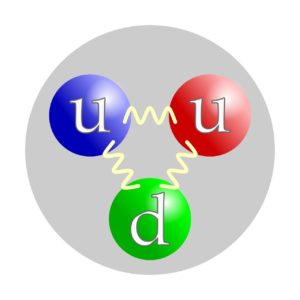
I learned this today. Quarks are elementary particles that make up the fundamental constituents of matter.
Everything that has matter in the universe is made up of atoms. The screen you are reading this on is made of glass (probably), which is basically silica. Silica has one silicon atom with bonds to four oxygen molecules. Inside one of the oxygen molecules are eight protons, eight neutrons, and eight electrons. Inside the protons and the neutrons are even smaller particles called quarks. Each proton and neutron contain three quarks.
There are six different pairs of quarks: up/down, charm/strange, and top/bottom. These are called flavors. The top/bottom quarks have the most mass. They interact with the Higgs boson to pick up this mass. They are very unstable and decay in a fraction of a picosecond. When they decay, they become the charm/strange pair of quarks. These have less mass and are a little more stable, but they too decay very quickly and become the up and down quarks. The up/down quarks have the lowest mass and are the most stable. All of the other quarks decay into the up and down quarks. Because they are stable, they make up most of the matter in the universe.
Each quark carries a charge. An up quark has a charge of +2/3 and a down quark has a charge of -1/3. There are three quarks in a proton and three quarks in a neutron. A proton has two up quarks and one down quark: +2/3 +2/3 -1/3 =1. A neutron has one up quark and two down quarks. +2/3 -1/3 -1/3 =0. This is why protons have a positive charge and neutrons have no charge.
The protons and neutrons are held together in the nucleus of the atom by the strong force. Two protons would try to push each other out of the nucleus because like charges repel each other, but the strong force overcomes this. Quarks are fast-moving points of energy and not “things” like the proton and the neutron. They are held together by gluons. A gluon is an elementary particle that acts as the exchange particle for the strong force between quarks. Without gluons, the quarks wouldn’t stay where they are and we wouldn’t have any protons and neutrons, which means we wouldn’t have anything.
One of the many interesting things about quarks and gluons is that you cannot have individual quarks. The force of the gluon holds the quarks together and this force doesn’t get weaker with distance. If you manage to remove one quark from a proton, they will immediately create another quark from out of the vacuum of space and the two individual quarks will instantly become pairs again. It is basically impossible to have a single quark.
There are six flavors of quark, but there are also six flavors of antiquark as well. When the universe began, there was an equal amount of matter and antimatter. For every quark that exists, there is an antimatter quark that also exists. These quarks are inside protons and neutrons and the antiquarks are inside antiprotons and antineutrons. When they collide, they produce a large amount of energy, and they can produce other elements. If an up quark collides with an anti up quark, it produces energy and an electron and a positron. A positron is an antielectron.
The idea of quarks was first suggested in 1964 by physicists Murray Gell-Mann and George Zweig. They were doing experiments on particles and found that electrons were scattering more widely than their calculations suggested. There were three locations where the electrons were scattering, which meant that something was causing the scattering. Their basic suggestion was that the particles scientists new about were not the elementary particles that people thought they were. They posited that these particles were made up of something smaller. It wasn’t until 1968 that it could actually be proved.
The name “quark” actually comes from James Joyce’s book, Finnegans Wake. Gell-Mann wanted to call them kworks. Then he read the line “Three quarks for Muster Mark!” in the book and decided that he would spell it that way. The fact that all protons and neutrons have three quarks being a sign of fate.
So, quarks are points of energy that make up the protons and neutrons inside everything in the universe. They give protons their positive charge and they are always grouped together. They were only discovered in the 1960s and are impossible to see. And this is what I learned today.
If you read this far, I would appreciate a like and a follow.
Image By Arpad Horvath – Own work, CC BY-SA 2.5, https://commons.wikimedia.org/w/index.php?curid=637353
Sources:
https://en.wikipedia.org/wiki/Quark
https://en.wikipedia.org/wiki/Charm_quark
https://en.wikipedia.org/wiki/Top_quark
https://en.wikipedia.org/wiki/Top_quark
https://en.wikipedia.org/wiki/Flavour_(particle_physics)
https://www.thoughtco.com/quark-2699004
http://abyss.uoregon.edu/~js/glossary/quarks.html
https://en.wikipedia.org/wiki/Atom
https://www.sciencefocus.com/science/is-there-anything-smaller-than-a-quark/
https://en.wikipedia.org/wiki/Preon
https://www.dkfindout.com/us/science/solids-liquids-and-gases/inside-an-atom/
https://scienceline.ucsb.edu/getkey.php?key=990
https://en.wikipedia.org/wiki/Atomic_nucleus
https://www.pbs.org/wgbh/aso/tryit/atom/elempartp.html
https://astronomy.com/magazine/ask-astro/2014/05/quark-antiquark

